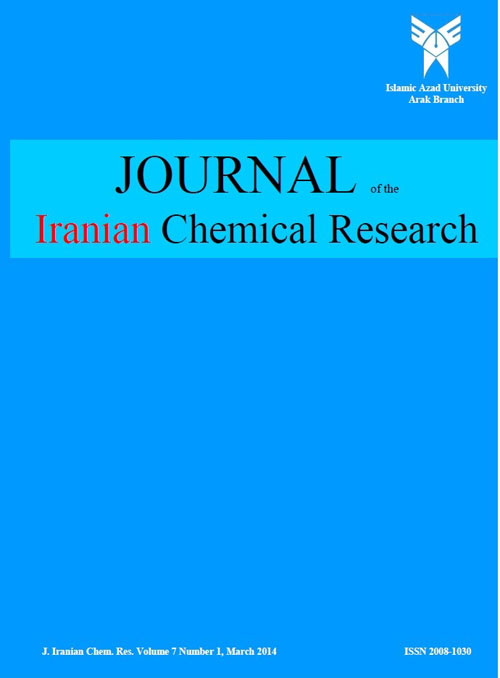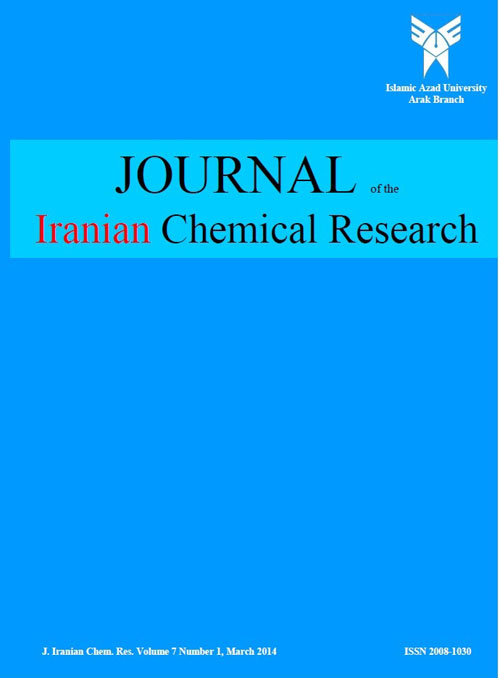فهرست مطالب

Journal of the Iranian Chemical Research
Volume:3 Issue: 4, Autumn 2010
- تاریخ انتشار: 1389/09/30
- تعداد عناوین: 8
-
Pages 211-217CeCuO3 nanoparticles with diameter 4.36 nm was synthesized by a fast and simple microwave method using cerric sulphate tetra hydrate and copper sulphate pentahydrate as starting reagents. CeCuO3 was synthesized under microwave heating for 6 min without calcining steps. The synthesized products were characterized by X-ray powder diffraction (XRD) and scanning electron microscopy (SEM) and the photocatalytic behaviour of nanosized CeCuO3 was also studied spectrophotometrically through decolorization of yellowish orange and fast green dyes, a prompt water pollutant from textile industries. The effect of variation of different parameters i.e. pH, amount of CeCuO3, concentration of dye and light intensity was observed on the rate of photocatalytic bleaching. A Tentative mechanism for the photocatalytic bleaching of dyes has been proposed.Keywords: Photocatalyst, CeCuO3, Fast green, Yellowish orange, Dye, bleaching
-
Pages 219-235The objective of this study was to assess the adsorption potential of activated carbon (AC) as an adsorbent for the removal of Murexide (Mu) from aqueous solutions. The influence of variables parameters including pH, amount of adsorbent, sieve size of adsorbent, temperature and contact time on Mu removal was studied. Following optimization of variables, the relation between concentrations of dye remained in aqueous and adsorbent has been evaluated using various adsorption isotherm models like, Langmuir, Freundlich, Tempkin, Harkins-Jura and DubininRadushkevich. Thermodynamic parameters such as enthalpy (ΔH◦), and, entropy (ΔS◦), activation energy (Ea), sticking probability (S*), and Gibbs free energy changes (ΔG◦) were also calculated. It was found from evaluated different thermodynamic parameters, viz., ΔH◦, ΔS◦ and ΔG◦ that the adsorption of Mu by AC was feasible, spontaneous and endothermic process. The kinetic studies suggest that the all process following pseudo second order kinetics and involvement of intera- particle diffusion mechanism. The results indicated that the intraparticle diffusion also is the rate limiting factor.Keywords: Adsorption, Murexide, Activated Carbon, Adsorption Isotherm, Thermodynamics, Kinetic of adsorption
-
Pages 237-243The melt-phase synthesis of dioctyltin (IV) and triphenyltin (IV) benzoates were carried out using stoichiometric amounts of benzoic acids and the corresponding organotin (IV) compounds. The reagents were ground together in a mortar and fed into a boiling glass tube. A cannula tube was inserted into the boiling tube to discharge accumulated gaseous products. A syringe ensured a continuous flow of dry Nitrogen gas in the reaction vessel. The compounds are known using wet Chemistry. Their syntheses via the melt-phase were in good yields. The physical properties corresponded to those of the similar compounds prepared by wet chemistry. The IR, 1H and 13C NMR data indicate that coordination to the tin atom is via carboxylate group.Keywords: Organotin, Melt, phase, Carboxylate group, Benzoic acid
-
Pages 245-256Densities and excess molar volume of the binary and ternary mixtures formed by nbutylacetate 1-butanol 1,2-butanediol were measured at (298.15, 303.15, and 308.15) K for the liquid region and at ambient pressure (81.5) k Pa , for the whole composition range.
The excess molar volumes,Vm E and excess partial molar volume Vi E ,were calculated from experimental densities.The excess molar volumes are positive over the mole fraction rage for binary mixtures of n-butylacetate (1) 1-butanol (2) and n-butylacetate (2) 1,2-butanediol (3) and increase with increasing temperatures from (298.15 to 308.15)K. The excess molar volumes of 1-butanol (1) 1,2-butanediol (3) are negative and decrease with increasing temperatures from (298.15 to 308.15)K..The experimental data of constitute were correlated as a function of the mole fraction by using the RedlichKister equation for binary and , Cibulka, Jasinski and Malanowski , Singe et al, Pintos et al , Calvo et al, Kohler, and Jacob - Fitzner for ternary mixture ,respectively. The experimental data of the constitute binaries are analyzed to discuss the nature and strength of intermolecular interactions in these mixtures.Keywords: Excess molar volume, n, butylacetate, 1, butanol, 1, 2, butanediol, Molecular interactions -
Pages 257-269A two-dimensional CFD model of a planar solid oxide fuel cell (SOFC) has been developed. This model can predict the performance of SOFC at various operating and design conditions.
The effect of Knudsen diffusion is accounted in the porous electrode (backing) and reaction zone layers. The mathematical model solves conservation of electrons and ions and conservation of species. The model is formulated in COMSOL Multiphysics 3.4, a commercial Finite Element Method (FEM) based on software package. The objective of the present study is to compare the results obtained from FEM with Control Volume Method (CVM) results obtained by Hussain et al. Both sets of results are compared with the experimental data published in literature. The results obtained by FEM show more accurate agreement with the experimental data. Finaly, the effect of various operating and design parameters on the performance of SOFC has been
examined.Keywords: Solid Oxide Fuel Cell, Reaction zone layers, Modeling, COMSOL Multiphysics -
Pages 271-278Lead forms the complexes with xylenol orange in the basic solution. An adsorptive differential pulse stripping method for the determination of lead is proposed. The procedure involves an adsorptive accumulation of lead on a hanging mercury drop electrode (HMDE) in the presence of xylenol orange, followed by reduction of adsorbed lead by voltammetric scan using differential pulse modulation. The optimum experimental conditions are: xylenol orange concentration of 0.20 μg mL-1, pH 10.5, accumulation potential of -900 mV versus Ag/AgCl, accumulation time of 200 s, scan rate of 10 mV s-1 and pulse height of 100 mV. The peak current is proportional to the concentration of lead over range of 0.03-0.65 μg mL-1, and the detection limit is 0.01 μg mL-1. The relative standard deviations (n=3) for 0.10 μg mL-1 lead is 0.86%, respectively. The proposed method was applied to the determination of lead in hair and water samples with satisfactory results.Keywords: lead, Determination, Stripping, Differential pulse voltammetry, Hair, water
-
Pages 279-286An efficient, rapid, simple, and highly selective dispersive liquidliquid microextraction based on solidification of floating organic drop (DLLME-SFOD), combined with flame atomic absorption spectrometry was developed for preconcentration and determination of trace amounts of cobalt in water samples. In this method, an appropriate mixture of acetone and 1-undecanol was injected rapidly into the aqueous sample containing cobalt-2N1N complex, as a result cloudy mixture was formed. After centrifugation, the test tube was cooled for 5 min. The solidified 1-undecanol on top of the solution was transferred into a suitable vial. Then, it was dissolved in 100 μL of methanol and finally introduced into the flame atomic absorption by microsampler injector. Several factors influencing the microextraction efficiency, such as the nature and volume of organic solvent, pH of aqueous solution, amount of complexing agent, stirring rate and extraction time were investigated and optimized. Under the optimum conditions, the enhancement factor was 68. The limit of detection, 6 μgL−1 and relative standard deviation (RSD) 2.64% (n=8) were obtained. The proposed method was applied to the analysis of various water samples.Keywords: DLLME, cobalt, Water analysis, Flame atomic absorption spectrometry
-
Pages 287-297Kinetic study of epoxidation of unsaturated ketone of mesityl oxide was studied by using Hydrogen peroxide in the presence of dodecyltrimethyl ammonium bromide (DTAB) as an inverse phase transfer catalyst. The reaction was carried out in the two-phase media of waterheptane with 1:1 ratio in 25 °C. It was found that the order of reaction for mesityl oxide for ketone concentration in the range of 0.03- 0.1 mol L-1 are 0.8906. And also with regard to catalyst concentrations in the range of 0.07- 0.2 mol L-1, the order of reaction for catalyst is 0.1205. The order of reaction of Hydrogen peroxide in the range o of 1.5-4 mol L-1 concentration for mesityl oxide is 0.1411. The activation energy of the reaction is 27.51 kJ mol-1 in the restricted temperature between 10-25 °C and it was observed that reaction rate enhances by temperature increase. As the phase transfer catalyst depends strongly on mass transfer between two phases, it is well understood that ultrasonic waves have a greater efficiency of interface mixing than conventional agitation. So, in this research the effect of ultrasonic waves in comparison with magnetic stirrer was studied. The results showed that an ultrasonic wave accelerates on the reaction.Keywords: Kinetic study, Epoxidation, Ultrasonic waves, Inverse phase transfer catalyst


